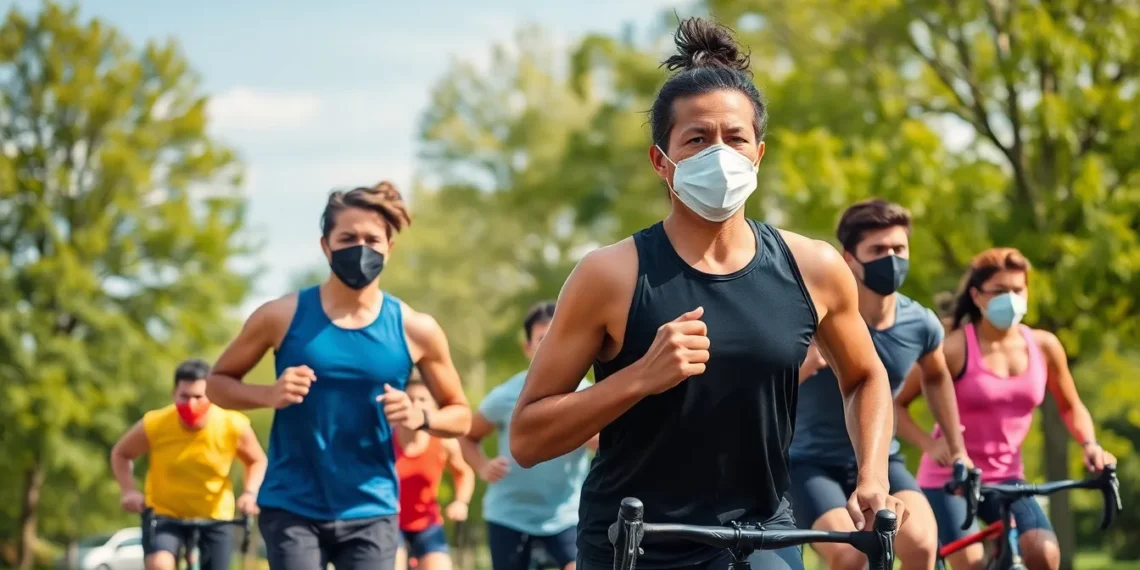In the world of sports, athletes push their bodies to the limit, but what happens when an invisible foe like COVID-19 enters the game? Suddenly, respiratory health takes center stage, and it’s not just about breaking records anymore. It’s about breathing easy while dodging the viral curveballs thrown their way.
Imagine sprinting towards the finish line while wearing a mask—sounds like a scene from a comedy, right? Yet for many athletes, this has become a reality. As they adapt to new challenges, understanding how to protect and enhance their respiratory health is crucial. From tailored training regimens to the latest research on lung function, athletes are learning to navigate this new normal. Join the journey as they tackle respiratory health head-on and discover how to stay in peak condition while facing the COVID-19 challenge.
Respiratory Health in Athletes: Facing the COVID-19 Challenge
Respiratory health plays a crucial role in athletic performance. Athletes rely on strong lung function to deliver oxygen efficiently during physical activities. As the pandemic alters training environments, understanding respiratory mechanics becomes essential.
COVID-19 significantly impacts those with existing respiratory conditions. Many athletes find themselves at greater risk of complications, highlighting the need for regular assessments. Lung function tests offer insights into athletes’ respiratory capabilities. These evaluations can reveal potential issues long before symptoms arise.
Adaptations in training are critical for maintaining respiratory health. Incorporating exercises that promote lung capacity and efficiency strengthens the respiratory system. Activities like interval training and aerobic exercises enhance cardiovascular endurance, benefiting overall lung function.
Wearing masks during workouts introduces a new layer of complexity. Some athletes report discomfort while breathing, making adaptation strategies vital. Proper mask selection can reduce airflow resistance and improve comfort levels. Choosing masks designed for athletic use could mitigate these concerns.
Research indicates that maintaining respiratory health may prevent performance degradation. Evidence supports that inhalation of dry air during intense exercise can irritate airways, increasing the risk of infections. Ensuring proper hydration and using humidifiers during training can protect lung function.
Continuous monitoring and tailored training regimens align with athletes’ specific needs. Strategies aimed at improving respiratory fitness not only boost performance but also enhance overall health. Athletes must prioritize respiratory well-being as they navigate the challenges posed by COVID-19.
Impact of COVID-19 on Respiratory Function

COVID-19 poses significant challenges for athletes, especially regarding respiratory health. Athletes experience both physiological and psychological changes impacting their performance.
Physiological Changes
COVID-19 affects lung capacity and function. Infected athletes may encounter inflammation in the respiratory system, leading to decreased oxygen exchange. Reduced lung capacity significantly influences endurance and performance levels. Studies indicate that those recovering from COVID-19 often experience lingering symptoms, such as shortness of breath and fatigue. Regular lung function assessments help monitor these changes and ensure athletes can adapt their training appropriately. Strengthening respiratory muscles through specific exercises remains crucial to optimizing lung function. Additionally, incorporating breathing techniques enhances overall performance by improving oxygen utilization.
Psychological Implications
Anxiety and uncertainty characterize athletes’ experiences during the pandemic. The fear of infection can create stress, affecting motivation and training consistency. Isolation from teammates complicates the mental aspect of training and competition. Many athletes report feeling overwhelmed by the constant changes in protocols and restrictions. Mental wellness exercises, such as mindfulness and visualization, support athletes in coping with these stressors. Furthermore, seeking guidance from sports psychologists can enhance athletes’ ability to adapt to the new normal. Prioritizing psychological health remains essential for maintaining overall performance and well-being.
Preventive Measures for Athletes
Athletes must adopt effective preventive measures to protect their respiratory health during the COVID-19 pandemic. These strategies enhance performance and sustain overall well-being.
Vaccination Strategies
Vaccination plays a critical role in safeguarding athletes against COVID-19. Vaccines reduce the risk of severe illness and promote quicker recovery, allowing athletes to return to training faster. Participation in vaccination campaigns ensures broader protection within the sports community. Staying informed about booster shots and current guidelines helps athletes maintain optimal immunity levels. Engaging with healthcare providers about vaccination options gives athletes insights into addressing their unique needs and concerns.
Health Monitoring Practices
Regular health monitoring significantly contributes to athletes’ respiratory health management. Routine assessments of lung function help identify potential issues early, crucial for those with pre-existing respiratory conditions. Tracking symptoms, including shortness of breath and fatigue, allows for timely adaptations in training programs. Utilizing wearable technology aids athletes in monitoring their heart rate and oxygen levels during workouts, promoting safer training environments. Collaborating with medical professionals ensures athletes receive tailored advice and support, enhancing overall performance and well-being.
Rehabilitation and Recovery
Rehabilitation and recovery play essential roles in maintaining respiratory health for athletes post-COVID-19. Customized approaches help athletes regain their strength and performance levels.
Tailored Training Programs
Customized training programs address each athlete’s specific needs. Professionals design these regimens based on assessments of lung function and overall health. Implementing progressive overload allows athletes to gradually increase intensity while monitoring respiratory status. Incorporating aerobic exercises fosters endurance and enhances lung capacity. Techniques such as interval training improve cardiovascular efficiency. Regular evaluations ensure adjustments as athletes recover, promoting safe and effective training.
Long-term Effects on Performance
Long-term effects of COVID-19 on athletes’ performance may persist even after recovery. Many athletes experience decreased lung capacity and lingering fatigue. When these issues arise, monitoring progress becomes critical. Documenting performance metrics helps identify trends and needed adjustments. The potential for reduced stamina and increased susceptibility to respiratory illnesses raises concerns. Athletes must integrate preventative measures and ongoing assessments into training plans. Consistent collaboration with medical professionals allows for targeted interventions, mitigating long-term consequences on athletic performance.
Conclusion
Athletes face unprecedented challenges to their respiratory health due to COVID-19. The pandemic has highlighted the importance of monitoring lung function and adapting training regimens to maintain performance. Strategies such as customized training programs and mental wellness exercises are essential for navigating this new landscape.
As athletes continue to adapt to the ongoing effects of the pandemic, prioritizing both physical and mental health will be crucial. By focusing on respiratory health and implementing preventive measures, athletes can not only enhance their performance but also safeguard their overall well-being. The journey ahead may be complex, but with the right support and strategies, athletes can emerge stronger than ever.















